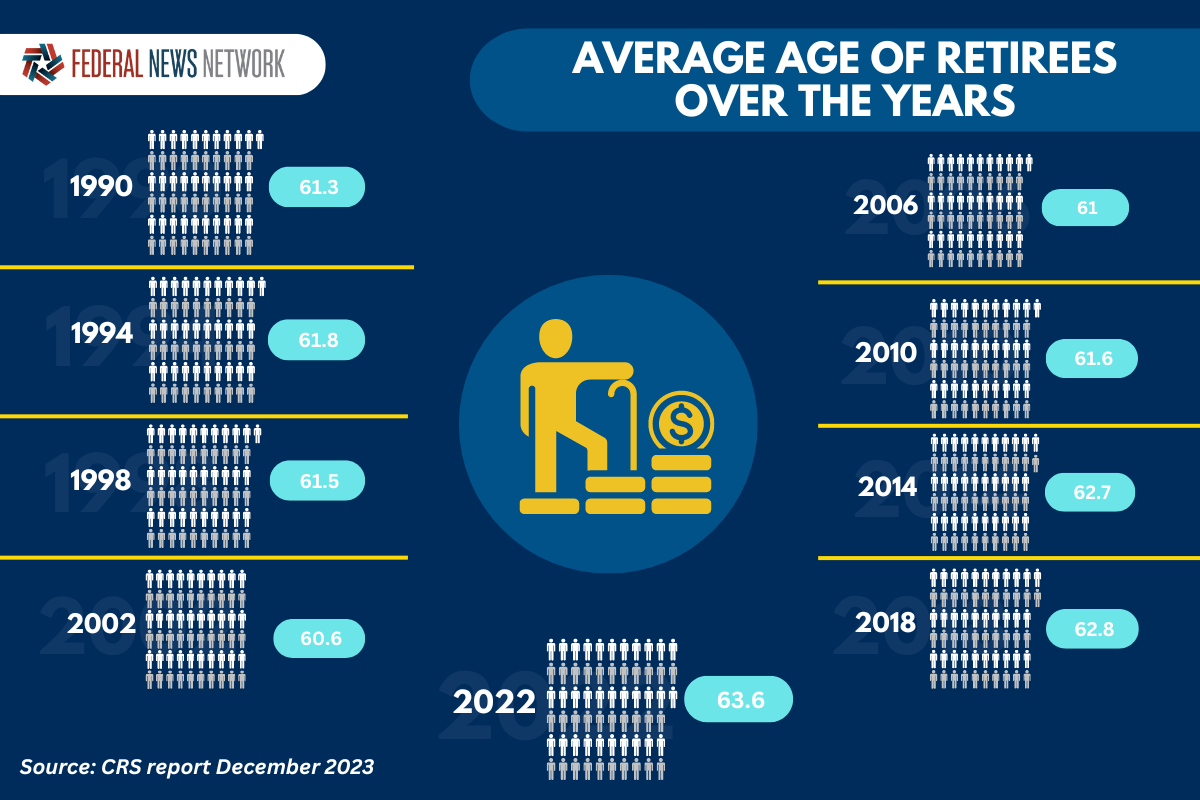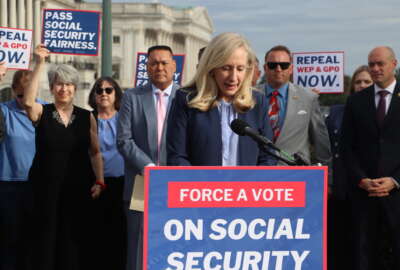Data Dive
Retirement by the numbers: Feds in CSRS are dwindling fast
Federal News Network dug into federal employee retirement data and found the number of retirees in CSRS and FERS to be almost equal.
The House is on the cusp of taking a major step toward the elimination of the Windfall Elimination Provision and the Government Pension Offset.
While finally putting a knife in the heart of the WEP/GPO still will take an act of the Senate, congressional support may be coming at the perfect time.
Federal News Network collected data that shows the number of retirees and survivors in the Civil Service Retirement System (CSRS), who would be impacted by this repeal, are reaching its peak. As of fiscal 2022 — the latest data available from the Office of Personnel Management — the number of active employees under CSRS was 44,000. By now, that number is surely smaller.
Meanwhile, the number of retirees in the Federal Employees’ Retirement System (FERS) soon will surpass CSRS retirees.
Tammy Flanagan, a federal retirement expert and principal at Retire Federal, said the history of WEP/GPO efforts has been fraught with failed repeal attempts.
“It’s very promising, but I don’t know what’s going to happen this time. I think because of the price tag on it, it may or may not pass. I think maybe some modification might happen in the Senate that would give it a better chance,” Flanagan said in an interview with Federal News Network. “I think for some folks, my husband, for example, it’d be nice for him to get his full, unreduced Social Security, but do we need it to live on? No. But there are other people who can’t retire because of it. There has to be something to give some relief, mainly to widows and women who didn’t work as many years out outside the home, who are really the most affected by this windfall provision, as well as certainly the Government Pension Offset. I think a modification could be easier to pass, but this bill that’s before Congress is to eliminate it, abolish it all together.”
While the future of WEP/GPO remains in the hands of lawmakers, the data from the Congressional Research Service showed several other trends of federal retirees.
For instance, the average age of retirement for federal employees has slowly increased since 1990. The average age a federal employee retired was 61.3 years old in 1990. CRS found today it’s 63.6 years old.

Flanagan said there may be two reasons for the uptick in retirement age.
First, she said, it was ingrained in many FERS participants when the program first started that they would never have enough money to retire.
“There is a portion of our FERS employees who really caught on later in their career to the importance of investing and saving and managing volatility and all the things you have to know in order to have that stream of income in retirement. I do think we have some of our employees who just can’t afford to retire at 57,” she said. “We also have a lot of federal employees now who come into the government later in life, because they might have spent part of their career in the private sector, didn’t earn a pension, didn’t have lifetime health benefits, so now they’re coming in to make up for lost time. They’re entering federal service, maybe in their 50s, and they want to put in 15-20 years, which means we’re going to see a lot more people working till 70 these days.”
Additionally, people, generally speaking, are living longer and are more healthy and want to contribute in the workplace or society longer. A 2022 survey by Gallup found the average retirement age in the United States is 61 years old, which is a four year increase since 1991.
Additionally, Gallup found the length of retirement is longer too, 18.6 years for men and 21.3 years for women, up from 12.8 years and 16.6 years, respectively.
“I was really interested in looking at as I look at all these statistics and it’s hard to believe, but we’ve got two 2,535 retirees over age 100 and what’s even more interesting is that survivor annuitants, these are the people who outlived the retirees that you basically their spouses, we have 4,000 of those over age 100 so I think there’s a good reason why OPM does a little happy birthday letter when a retiree turns 100 because they want to make sure they get a return from that and they want to make sure that person’s still actually living,” Flanagan said. “To me, that’s an amazing number of our retirees who are over that age. Just the number over age 90 is close to 100,000 when you compare the survivor annuitants and the employee annuitants. So federal retirees live a long time. This says something good for a federal career.”
Many retirees will say they are making more money as a CSRS retiree than they did when they worked. The data shows the mean monthly income is about $4,464 and median monthly income is $3,897 for folks in the old system.
Flanagan said while the monthly income of FERS employees may be smaller overall, she said many that she talks to are more than satisfied with the program.
“FERS was never meant to stand alone. So those employees, you might feel sorry for them, saying, ‘Oh, look at the small annuity.’ But heck, these are the people who have a million dollars in their Thrift Savings Plan. They’re getting a FERS supplement that takes the place of Social Security, so they can still retire at a relatively young age. So FERS always was meant to be this three level system, and I’m seeing today FERS employees who are in every bit as good of financial shape as our CSRS employees were, as much as we were really not wanting to switch to FERS back in 1987 and saying ‘whatever Congress does must be good for the government, not good for us,’” she said. “We had all these negative thoughts about FERS, but it’s really turned out to be quite a good system. It provided more flexibility that gave the opportunity to control more of your streams of income in retirement. I’ve really liked how it’s turned out. I think a lot of employees, given the choice, would not switch back to CSRS; at least we still have a pension.”
Speaking of the pension, the Social Security Administration is expected to announce the cost of living increase (COLA) for retirees as early as next week.
CSRS employees traditionally received a higher cost of living increase, but over the last 11 years, the COLA has been the same eight times.
Flanagan said the states with the highest number of federal retirees is always surprising: California, Florida and Texas. The states with lowest number of federal retirees include Vermont, North Dakota and Wyoming.
“I don’t know if this is what Congress had in mind or not when they developed FERS, but it seems like this system was designed to keep you in the government until you’re at least 62. When someone wants to retire at 57 with just 30 years of service, oftentimes I look at the numbers for them and I’ll be like, you’re going to be retired for the next four decades, maybe five and so you want to make sure that TSP is going to last you all that time,” she said. “I run the numbers for them at 57 but then I’ll do it again at 60 or 62 because it’s a huge difference. The reason why is because at 62 if you’ve got 20 years of service or more, you get a 10% bonus. The FERS basic benefit doesn’t get a cost of living adjustment. So imagine being 57 at retirement, never getting an increase, especially over these last five years, when we’ve had inflation running between 5% and 8% a couple of those years, Without that COLA, you might find yourself back at work before you’re 62. We got the Social Security piece payable at 62. We got the COLA not payable till 62 and then the bonus. So there’s a lot of things that point towards 62 being the new magic age for retirement.”
Obviously, there is a ton of more data to pull from. Tell me what you thought of this data dive and what other data would you like to see.
Copyright © 2024 Federal News Network. All rights reserved. This website is not intended for users located within the European Economic Area.
Jason Miller is executive editor of Federal News Network and directs news coverage on the people, policy and programs of the federal government.
Follow @jmillerWFED






